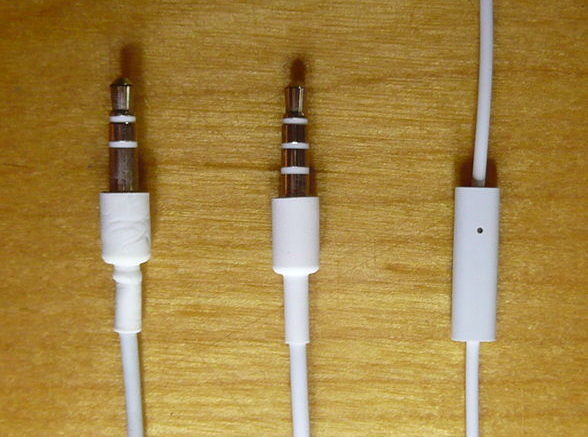Take a look at these two connectors. Notice anything different? One has two white pieces of plastic at the end, one has three. That’s because they are technically different connectors. Let me back up a little bit.
The original history of the headphone plug

Back in the early 20th century, the phone company used actual humans connecting actual cables to connect phone calls. You might have seen this in old pictures, or perhaps seen a more recent movie like Changeling which depicts an old switchboard in action. In order to make switching easy, the phone company developed a technology where the two wires needed for a phone connection were consolidated into a single plug, known at the time as a “TT” or “tiny telephone” plug.
The original 1/4″ connector
That plug evolved into what we now commonly call a 1/4 connector, which should be familiar to you if you play guitar or use any pro-quality audio equipment. It’s still a favored connection point for anyone who really cares about analog audio.

The 1/4 connector used in guitars is technically called a “TS” connector – there’s a tip, and then a plastic spacer, and the long cylindrical part is referred to as a sleeve. This corresponds to the two connections (signal and ground) needed for this sort of connection. If you’re old enough, you might remember that at one time earphones used a smaller version of the TS connector in the days when they only went into one ear.
The 3.5mm (1/8″) connector
Given that space is always at a premium in mobile devices, the standard for the last 30 years in audio hasn’t been the 1/4″ connector but it’s 3.5mm version. The key difference is the addition of an additional segment so two signal wires can be used and you get stereo audio. When a TS connector has an extra segment between the tip and sleeve, they call that part a ring, and hence the proper name for the connector is TRS. This single connector is one of the most common things you’ll find, because everyone wants to listen to something.
Then it gets really interesting
In the 2000s, the TRS connector evolved even further, gaining a second ring. This allowed for three signals on one wire. It was originally used for video gaming systems to provide audio and video through the same plug, but it evolved for use in portable video players as well. And then, Apple stepped in. By using a TRRS (two rings, get it?) connector for its iPhone earbuds, all of a sudden the headphone became a phone headset. This has become the almost default use of the TRRS connector and as such you can pretty much use any headset with this connector on any phone.

Believe it or not the evolution isn’t over. What you see above is a TRRRS connector, with three rings between tip and sleeve. This allows for five wires to connect to a single 1/8″ plug. The fourth signal wire allows for noise cancellation, control, or anything the manufacturer wants. It’s still fairly new and not standardized, at least until Apple gets its hands on it and claims it invented the thing. Then, we’ll find out what it’s supposed to be used for.
In the meantime, here’s a quick tip (these are the jokes, folks) on how to use these plugs. If you see only one plastic ring, well get rid of that, it’s an antique. Are you looking at one with two rings? That’s a headphone. If you see three, that lets you talk. On the other hand if you see four, hey, just run away.
Do you even care about this with Bluetooth?
Of course the trend in the last five years has been to do away with wired headphones. This has been driven mostly by manufacturers who don’t want a jack that takes up precious space. People like wireless headphones, but in general the sound quality is not as good as wired ones. Bluetooth headphones turn the analog audio to digital and compress it as it’s transported. This can mean lower quality, although most people won’t notice the difference.
A true audiophile is always going to want a wired connection, but for the rest of us, Bluetooth does make sense. But, whenever you need an accessory like an old-school audio cable, shop the great selection at the all new SolidSignal.com!





